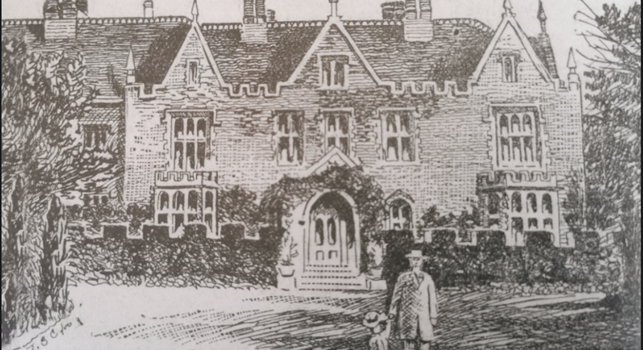Of the many fragile artefacts we store at the Museum of Cambridge few can be as beautiful and mysterious as the four sketchbooks we have of Cissy, dating from 1899 to around 1912.
In 1892 the Rev. William Macfarlane purchased a farm in Impington, just north of Cambridge. He inherited his uncle’s estate, changed his name to Macfarlane-Grieve and in 1899 moved to Impington Hall, opposite the ancient parish church. This house had been built by John Pepys in 1579 and by 1650 was owned by Talbot Pepys, uncle of the diarist Samuel. It was described in the late 18th century by the historian William Cole:
“The House pleased me much and is the best of the sort I ever saw. A noble entrance hall is in the centre with 2 Corinthian pillars on one side. There is a common dining Parlour and Kitchen, and on the other side an elegant Dining Room and Drawing Room, and by the hall a most beautiful Salon and Staircase with an open space to the top of the house with a gallery to which all the bedchambers have entrance, the whole elegantly fitted up and furnished, overloaded with carving and stucco.

William died in 1917 and left his estate to his son, R W Macfarlane Grieve, who went on to sell a significant part of it to the local jam maker, Chivers, in 1926. The house itself was taken over by Chivers as an educational establishment until World War II when it was used by the Royal Engineers to billet troops and then to house Italian prisoners of war. It was demolished in the early 1950s and nothing seems to survive now except the stone balls on the pillars at the entrance to Percheron Close.
However, it is with his daughter Evelyn we are most concerned. Very little survives about her life even though her brothers are well documented. In 1901 she is Evelyn Mary, aged 15. She doesn’t appear in the 1911 census at Impington Hall. In 1915 she dies in London at 51 Welbeck Street, aged 28. She is unmarried even though there is fleeting evidence that she had suitors. Who was she really?
The first of the four sketch books dates from 1899, the year she moved to Impington. She describes herself as 13 and is very protective of her book, warning others not to steal it! Very soon the ‘reader’ starts to ask the questions, what are these sketches of? Who are these people? On the opening page she lists the children of the Courtenay family, ten of them, six girls, four boys aged between 13 and 3. Who are they?
The evidence of the pictures is that the characters are dressed in contemporary garb, but not all. Several of the pictures have captions in quotation marks. So are these illustrations of scenes from a story? If so, whose story?

There are occasional allegorical scenes, ‘Spring’, and others that are in an historical setting. The picture ‘The fight at Carlo’s bridge’ seems to be set in the 16th century or thereabout. Are all these depicting events in the life of the Courtenay family? Who is the queen in the picture ‘The Queen strove vainly to comfort her’?

We then start to see a recurring scene, that of children sitting in church, but seen from behind. At first these are the Courtenay children. We learn that Mrs Courtenay is a widow and that the children go to school. Other people appear in the pictures but by the end of the first album their identify is still vague. However, Cissy is very careful to note exactly how many times each member of the Courtenay family has appeared in her sketch book.
The second sketchbook is dated 1899-1900. Cissy notes, ‘The children in the drawings are quite real and are living at the present time.’ Is this actually true?

We seen a lot of illustrations in the lives of the Courtenay family but then she starts to name other children in the pictures, especially those in church. Vicky Water, Mable Elsom, Sarah Wakefield. These are all girls that we can find in the 1901 census living in Impington. There are others. All real. But the Courtenays? Nothing. They seem to be entirely fictitious. Yet there they are, sitting behind the real children in church, in picture after picture.

These sketches are beautiful and depict, in meticulous detail and colour, the costumes, especially hats, of the time. We see families going for a walk, with their toys and post-carts. They are outside Kimpton’s the grocers, a shop that is listed in the 1901 census. Kimptons are buried in the Impington church grave yard. We see details of the church and, after a site visit, these are indeed realistic details of the pews that Cissy would have seen. However, there are oddities. We see in one sketch, Mrs Courtenay, in the costume of a woman of 1901, walk down the central aisle of the church past the tomb of Hugo Courtenay dated 1483. No such tomb exists at Impington church. Is this imagined?

The fourth volume of sketches is entirely different. Dated 1907, these are accomplished pen and ink drawings that depict a range of themes, some allegorical, others illustrating poems, songs or superstitions. The world of the Courtenays is entirely left behind and instead we have a very beautiful set of sketches that stand as artistic creations in their own right.
So, are these sketchbooks a mysterious combination of real contemporary Impington circa 1900 mixed with an entirely imaginary family, a superimposed family with their own imagined story-line, all the product of a gifted and imaginative teenage girl?
See below for more information:
